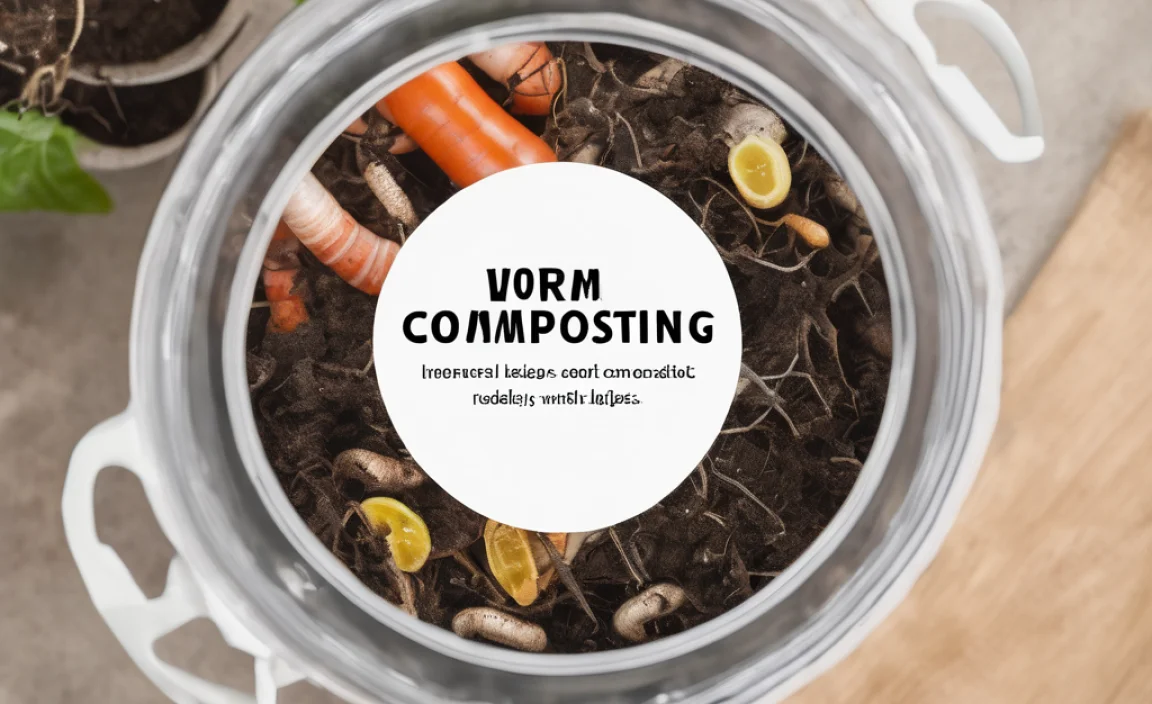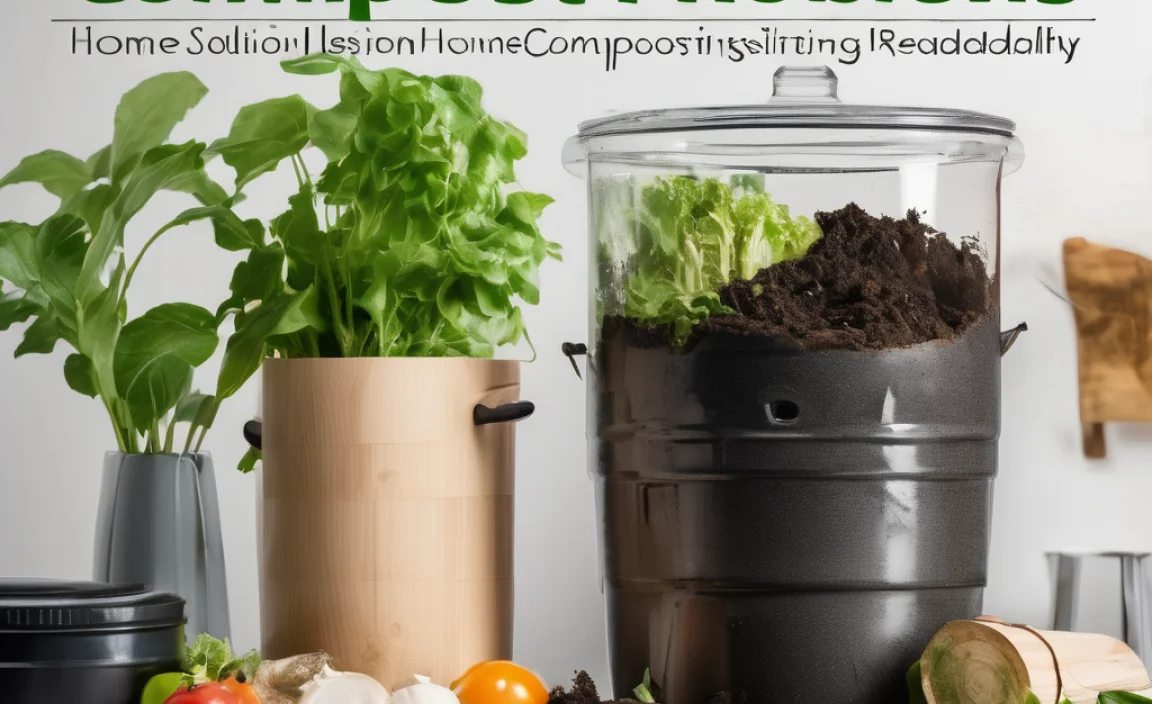Have you ever wondered how worms can turn trash into treasure? Vermicomposting is an exciting way to recycle food scraps. It uses worms to turn waste into rich soil. But, what about the vermicomposting cost? Is it affordable for everyone? Let’s dig into this fascinating world and find out!
Key Takeaways
- Vermicomposting is an eco-friendly way to recycle food waste.
- Initial setup vermicomposting cost can be low or high, depending on choices.
- Worms turn waste into nutrient-rich compost.
- You can save money on fertilizers by vermicomposting.
- Vermicomposting reduces the waste sent to landfills.
Understanding Vermicomposting Costs
Starting a vermicomposting project is not just about worms. It involves some planning too. You might wonder, “How much will it really cost?” The vermicomposting cost can vary. If you choose to make a bin yourself, it might be cheaper. Buying a ready-made compost bin might cost more. You also need to buy worms. Red wigglers are the best! They can be purchased online or from local suppliers. Don’t worry; they’re not too expensive!
- DIY bins can be made from plastic containers.
- Ready-made bins offer convenience and design.
- Worms can be bought by the pound.
- Location affects worm shipment costs.
- Worms need a safe, moist, and dark place.
- Food scraps serve as free worm food.
- Ongoing costs are minimal after setup.
To make it even more interesting, let’s compare some choices. Here’s a simple table to help you understand potential costs:
| Item | DIY Cost | Store-Bought Cost |
|---|---|---|
| Compost Bin | $5 – $20 | $30 – $100 |
| Worms (per pound) | $15 – $30 | $15 – $30 |
| Bedding Material | $0 (newspaper) | $5 – $10 |
| Ongoing Costs | Minimal | Minimal |
The table shows you can start vermicomposting without spending a lot. You can even use things from home. It’s a fun way to recycle and learn about nature!
Fun Fact or Stats : A pound of worms can eat half their weight in food daily!
What is Vermicomposting?
Vermicomposting is a special composting method. It uses worms to break down food waste. Have you ever thought about where your food scraps go? Instead of going to the trash, they become rich soil! This soil is called compost. It’s great for gardens and plants. The worms make the process faster and more efficient. It’s like having a tiny recycling team at home!
Why Choose Vermicomposting?
Why should you try vermicomposting? For starters, it’s eco-friendly. Imagine reducing the trash you throw away. Worms help turn that waste into something useful. Plus, vermicomposting is easy and fun. You can watch nature work its magic right in your own home. It’s a great way to learn about recycling and caring for the planet. Who knew worms could be so helpful?
How Do Worms Help?
Worms are nature’s little recyclers. They eat food scraps and break them down. This creates rich compost for plants. Have you ever seen worms wiggling through the soil? They’re busy making it healthy. Worms also aerate the soil, allowing plants to grow better. In vermicomposting, worms work hard to transform waste into garden gold. Their hard work keeps the environment healthy.
Making a Worm Bin
Creating a worm bin is simple and fun. Start with a container. It can be plastic, wood, or metal. The size depends on how much waste you have. Worms need a cozy home to do their job. Drill holes in the bin for air. Worms breathe through their skin, so air is important. Line the bottom with bedding. Shredded newspaper or coconut coir works well. Add your worms and some food scraps. Remember, worms don’t like too much light.
- Choose a bin size that fits your space.
- Plastic bins are cheap and easy to find.
- Drill holes for proper ventilation.
- Line the bin with damp bedding.
- Add worms and food scraps gradually.
- Too much light can stress worms.
- Locate the bin in a cool, dark place.
Building a worm bin is a fun project for families. Children can learn about recycling and nature. It’s also a great opportunity to bond while creating something useful. Over time, you’ll see food scraps turning into rich compost. It’s hands-on learning at its best!
Fun Fact or Stats : Worms can eat their weight in food every week!
Choosing the Right Worms
Not all worms are good for composting. The best choice is the red wiggler. Why red wigglers? They are efficient and love to eat! These worms thrive in compost bins. Unlike earthworms, they prefer the top layer of soil. This makes them perfect for bins. You can buy red wigglers online or at garden stores. They’re small, but they have a big appetite for food scraps.
Setting Up the Bedding
Worms need a comfortable bed to work in. Bedding provides a moist environment for them. Shredded newspaper is a great option. It’s cheap and absorbs moisture well. You can also use coconut coir, straw, or cardboard. The bedding should be damp, not soggy. Mix it well and add it to the bin. It’s the worms’ home, so make it cozy!
Feeding the Worms
What do worms eat? They love vegetable scraps, fruit peels, and grains. Avoid dairy, meats, and oily foods. These can attract pests and smell bad. Before adding food, chop it into small pieces. Smaller pieces decompose faster. Add food scraps gradually. Cover them with bedding to keep flies away. Soon, you’ll see the worms working hard to turn waste into compost.
Benefits of Vermicomposting
Vermicomposting offers many benefits. It’s a sustainable way to handle food waste. Instead of filling landfills, you create rich compost. This compost improves soil quality. Plants grow healthier and stronger with it. Using compost reduces the need for chemical fertilizers. This saves money and protects the environment. Plus, vermicomposting is educational and fun!
- Reduces waste sent to landfills.
- Produces nutrient-rich compost.
- Improves soil structure and health.
- Saves money on fertilizers.
- Engages families in eco-friendly projects.
- Educates about natural processes.
- Great for small spaces and urban areas.
Vermicomposting is also a great way to teach children about sustainability. They learn how food waste can be recycled. It shows them the importance of caring for our planet. With vermicomposting, everyone can contribute to a healthier Earth. Start small and watch the benefits grow!
Fun Fact or Stats : One ton of worms can consume up to 1,000 pounds of food scraps daily!
Environmental Impact
Did you know that vermicomposting helps the environment? It reduces the amount of waste sent to landfills. When waste decomposes in landfills, it produces methane, a harmful gas. Vermicomposting cuts down on this gas and creates useful compost. This process helps reduce pollution. It also conserves resources by recycling organic waste. Vermicomposting is an easy way to make a positive impact.
Improving Soil Quality
Compost from worms enriches the soil. It adds nutrients that plants need to grow. Have you ever noticed how healthy plants look in rich soil? Vermicomposting helps achieve that. The compost improves soil structure. It holds water better, which reduces the need for frequent watering. Healthy soil supports strong, vibrant plants. Vermicomposting is a natural way to boost soil quality.
Saving Money
Vermicomposting can save you money. How? By reducing the need for chemical fertilizers. Compost provides essential nutrients for plants. It’s a free, natural alternative. You also save on waste disposal costs. Less waste means fewer trips to the landfill. Vermicomposting is cost-effective and beneficial. It’s a smart choice for budget-conscious gardeners.
Challenges of Vermicomposting
While vermicomposting has many benefits, it can come with challenges. Bins can attract unwanted pests if not managed properly. Too much moisture can lead to unpleasant smells. Worms need the right temperature to thrive. If it’s too hot or cold, they might become inactive. It’s important to monitor the bin regularly. Ensure the bedding is moist and the temperature is right. With care, these challenges can be managed effectively.
- Potential for pests if food is exposed.
- Requires monitoring for moisture and temperature.
- Worms can escape if conditions are poor.
- Bins should be kept indoors in cold climates.
- Overfeeding can lead to smells and problems.
- Regular attention is needed for best results.
- Requires learning about worm care.
Despite these challenges, many find vermicomposting rewarding. It teaches responsibility and problem-solving. Kids can learn a lot from taking care of the worms. Overcoming these challenges leads to successful composting. It’s a great way to practice patience and care. With some effort, vermicomposting can be a smooth and enjoyable experience.
Fun Fact or Stats : Worms can live up to four years in a happy environment!
Dealing with Pests
Pests in the worm bin can be a problem. How do you avoid them? Ensure food is covered with bedding. This keeps flies away. Avoid adding meat or dairy, as they attract pests. Keep the bin clean and check it regularly. If pests appear, remove food scraps and check moisture levels. Proper management keeps the bin healthy and pest-free.
Managing Moisture Levels
Too much or too little moisture can harm worms. The bedding should be as damp as a wrung-out sponge. If it’s too wet, add dry bedding. If too dry, sprinkle some water. Regularly check moisture levels to keep worms happy. Managing moisture helps worms thrive and work efficiently. This ensures successful vermicomposting.
Temperature Control
Worms prefer temperatures between 55-77°F. Extreme temperatures can stress them. In hot weather, move the bin to a cooler place. In winter, keep the bin indoors or add insulation. Monitoring the temperature ensures worms stay active. It’s important for their health and productivity. Proper temperature control results in effective composting.
Conclusion
Vermicomposting is an amazing way to recycle waste and enrich the soil. The vermicomposting cost can be minimal, especially with DIY options. With time, effort, and care, anyone can succeed at vermicomposting. It’s a fun, educational project for families. Plus, it’s good for the planet. Start small, learn as you go, and enjoy the benefits of composting with worms!
FAQs
Question: How much does vermicomposting cost to start?
Answer: The initial vermicomposting cost can range from $20 to $100. DIY options are cheaper, while ready-made bins cost more. Worms are an additional expense, costing about $15-30 per pound.
Question: What types of worms are used in vermicomposting?
Answer: Red wigglers are the best worms for vermicomposting. They thrive in shallow, organic-rich environments, making them perfect for compost bins. Red wigglers are efficient at breaking down food waste.
Question: Are there any ongoing costs for vermicomposting?
Answer: After the initial setup, ongoing costs are minimal. Worms eat food scraps, which are free. Occasionally, you may need to buy bedding material. The vermicomposting cost is generally low over time.
Question: Can vermicomposting be done indoors?
Answer: Yes, vermicomposting can be done indoors. It’s ideal for apartments or homes with limited outdoor space. Use a bin with a secure lid to control odors and pests.
Question: How do I maintain a worm bin?
Answer: Regularly check moisture levels and temperature. Add food scraps gradually and cover them with bedding. Ensure proper ventilation and avoid overfeeding. Regular maintenance keeps the bin healthy.
Question: How long does it take to get compost from vermicomposting?
Answer: It typically takes 3 to 6 months to produce usable compost. Factors like temperature, moisture, and the amount of food scraps affect the process. Patience and care lead to rich, valuable compost.


